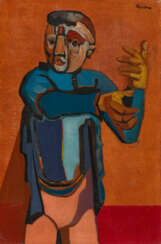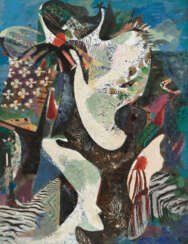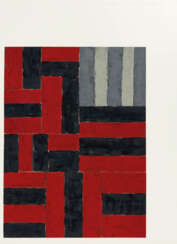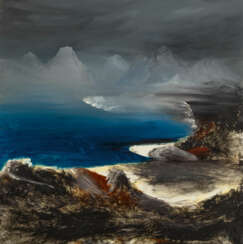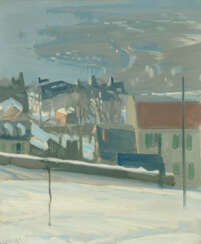
Paintings — The Private Collection of Mary and Alan Hobart - Pioneers of Modern British and Irish Art

Claude Debussy, full name Achille-Claude Debussy, was a French composer, conductor, pianist and critic, a leading representative of Impressionism in music.
Debussy showed musical talent early and entered the Paris Conservatory. He lived in poverty, but at the same time he learned a luxurious life: the Russian philanthropist and the richest woman, Nadezhda Filaretovna von Meck, took him under her tutelage, he mused with her children and traveled with her around Europe. His sensitive nature could not but respond to all these contrasts. During this period Debussy created one of his masterpieces, Moonlight from the Bergamo Suite.
Debussy spent the summers of 1881 and 1882 near Moscow, at the von Meck estate. In this house Debussy became acquainted with the new Russian music of Tchaikovsky, Borodin, Balakirev and Modest Mussorgsky. His stay in Russia had a beneficial effect on the young musician's development. Debussy was also influenced by the work of Richard Wagner. He developed a highly original system of harmony and musical structure that in many ways expressed the ideals to which the Impressionist and Symbolist artists and writers of his time aspired.
Debussy toured with concerts and conducted his works in England, Italy, Russia and other countries. Claude Debussy's famous works include the Prelude to the Afternoon of a Faun (1894), the operas Pelléas et Mélisande and The Sea (1905), the suite Children's Corner (1906-1908) and the orchestral cycle Images (1912). In 1913 he composed music for the ballet Games, which was performed by Sergei Diaghilev's Russian Seasons company in Paris and London.
Sean Scully is an Irish-born American-based artist working as a painter, printmaker, sculptor and photographer. His work is held in museum collections worldwide and he has twice been named a Turner Prize nominee. Moving from London to New York in 1975, Scully helped lead the transition from Minimalism to Emotional abstraction in painting, abandoning the reduced vocabulary of Minimalism in favor of a return to metaphor and spirituality in art.
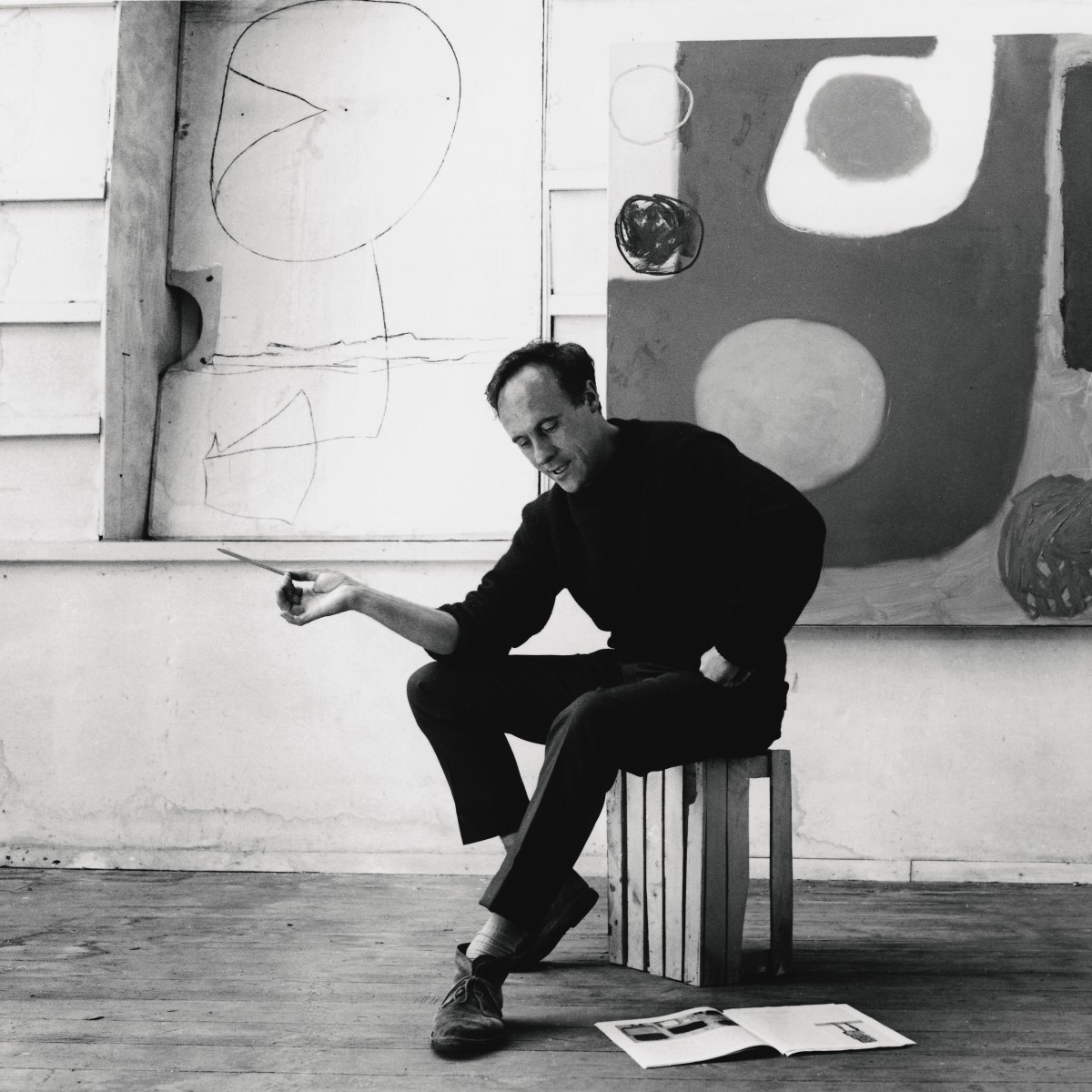
Patrick Heron was a British abstract and figurative artist, critic, writer, and polemicist, who lived in Zennor, Cornwall.
Heron was recognised as one of the leading painters of his generation. Influenced by Cézanne, Matisse, Braque and Bonnard, Heron made a significant contribution to the dissemination of modernist ideas of painting through his critical writing and primarily his art.
Heron's artworks are most noted for his exploration and use of colour and light. He is known for both his early figurative work and non-figurative works, which over the years looked to explore further the idea of making all areas of the painting of equal importance. His work was exhibited widely throughout his career and while he wrote regularly early in his career, notably for New Statesman and Arts New York, this continued periodically in later years.

Sidney Nolan was an influential Australian artist known for his diverse body of work and pioneering contributions to modern art. His most famous work centers on the Ned Kelly series, which depicts the life of the legendary Australian bushranger and outlaw. This series became iconic for its unique depiction of Kelly's armor and for symbolizing Australian history and identity.
Sidney Nolan was deeply interested in Australian history and mythology, often exploring themes of bush life and historical figures such as the Kelly Gang, shipwreck victim Eliza Fraser, and the explorers Burke and Wills. He was inspired by various modernist artists, such as Paul Cézanne, Pablo Picasso, and Henri Matisse, and his work often incorporated bold colors and simplified forms.
Despite lacking extensive formal art training, Sidney Nolan's approach to art was innovative and experimental. His techniques drew from diverse influences, including children's art and modernist styles, while his use of color and texture gave his work a striking visual impact. This diversity in approach led him to explore various media, ensuring his body of work remained varied and vibrant.
Sidney Nolan's legacy lives on through his paintings, which can be found in museums and galleries worldwide. He painted in series, creating visual poems with a significant emotional punch. His work's emotional expression and ability to engage the viewer on an emotional level are part of what makes his art so compelling and enduring.
To stay updated on new product sales and auction events related to Sidney Nolan, consider signing up for newsletters or updates from relevant art and auction houses. These updates can provide insights into new exhibitions, available artworks, and other events related to Nolan's work.

Sidney Nolan was an influential Australian artist known for his diverse body of work and pioneering contributions to modern art. His most famous work centers on the Ned Kelly series, which depicts the life of the legendary Australian bushranger and outlaw. This series became iconic for its unique depiction of Kelly's armor and for symbolizing Australian history and identity.
Sidney Nolan was deeply interested in Australian history and mythology, often exploring themes of bush life and historical figures such as the Kelly Gang, shipwreck victim Eliza Fraser, and the explorers Burke and Wills. He was inspired by various modernist artists, such as Paul Cézanne, Pablo Picasso, and Henri Matisse, and his work often incorporated bold colors and simplified forms.
Despite lacking extensive formal art training, Sidney Nolan's approach to art was innovative and experimental. His techniques drew from diverse influences, including children's art and modernist styles, while his use of color and texture gave his work a striking visual impact. This diversity in approach led him to explore various media, ensuring his body of work remained varied and vibrant.
Sidney Nolan's legacy lives on through his paintings, which can be found in museums and galleries worldwide. He painted in series, creating visual poems with a significant emotional punch. His work's emotional expression and ability to engage the viewer on an emotional level are part of what makes his art so compelling and enduring.
To stay updated on new product sales and auction events related to Sidney Nolan, consider signing up for newsletters or updates from relevant art and auction houses. These updates can provide insights into new exhibitions, available artworks, and other events related to Nolan's work.

Antoni Clavé was a Catalan master painter, printmaker, sculptor, stage designer and costume designer. He was nominated for two Academy Awards (Best Art Direction and Best Costume Design) for his work on the 1952 film Hans Christian Andersen.
Clavé was one of Spain's best known and most celebrated artists. His work evolved from a baroque, ornamental style to a pure, minimal aesthetic. In his later years, his work is completely abstract, employing expressive lines and exploring the boundaries of collage, objet trove, shading, texture and color. He was trained at the School of Fine Arts, Barcelona, where he was taught by Angel Ferrant and Felix Mestres. With his works being influenced by artists such as Bonnard, Vuillard and Roualt. He is best known for his lyrical abstractions, works which combine paint with collage.

Jules Bastien-Lepage was a French painter closely associated with the beginning of naturalism, an artistic style that emerged from the later phase of the Realist movement.
His most famous work is his landscape-style portrait of Joan of Arc which currently resides at the Metropolitan Museum in New York City.

Maurice Denis, a French painter and writer, was an influential figure in the transition from impressionism to modern art. Born on November 25, 1870, in Granville, France, Denis's artistic journey began at the Académie Julian in Paris. Here, he met future collaborators like Paul Sérusier and Pierre Bonnard, with whom he later formed the Nabis group, a collective deriving its name from the Hebrew word "Nabi," meaning "Prophet".
Denis's style evolved from neoimpressionism, influenced by artists like Seurat, to a more decorative and colorful approach under the influence of Gauguin. This shift is evident in works like "Taches du soleil sur la terrace" (1890). He famously stated, "Art is no longer a visual sensation... it is a creation of our spirit," highlighting his belief in art as an idealistic expression, transcending mere imitation of nature.
Denis was also impacted by Japanese art, which influenced his compositions and styles, contributing to his unique and recognizable approach. His philosophy on art, encapsulated in his 1890 essay published in "Art et Critique," emphasized the importance of color and form in creating emotional depth, a notion that laid the groundwork for modernism. He argued that a painting's essence lies in its colors and composition, rather than its subject matter.
Throughout his career, Denis's work evolved towards a more classical approach. His involvement with the Ateliers d'Art Sacré, founded in 1919, demonstrated his interest in religious art and decoration. His notable works include "The Legend of Saint Hubert" (1897) and "The History of Music" for the Théâtre des Champs Elysées (1912-1913).
Tragically, Maurice Denis's life ended on November 13, 1943, when he was struck by a truck during the German occupation of Paris. However, his legacy endures through his contributions to modern art and symbolism, his influence on fellow artists, and his works displayed in various museums and galleries.
For collectors and art experts, Denis's work offers a unique glimpse into the evolution of modern art. His blend of symbolism, color, and form marks a significant shift in art history. To stay updated on new sales and auction events related to Maurice Denis's work, sign up for our newsletter. This subscription will keep you informed about the latest developments in the world of this remarkable artist.

Walter Richard Sickert was a German-born British painter and printmaker who was a member of the Camden Town Group of Post-Impressionist artists in early 20th-century London. He was an important influence on distinctively British styles of avant-garde art in the mid- and late 20th century.
_(NPG_x13488).jpg)
_(NPG_x13488).jpg)

Roger Eliot Fry was an English painter and critic, and a member of the Bloomsbury Group. Establishing his reputation as a scholar of the Old Masters, he became an advocate of more recent developments in French painting, to which he gave the name Post-Impressionism.















